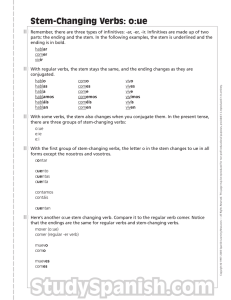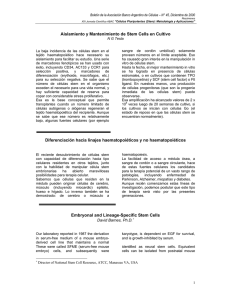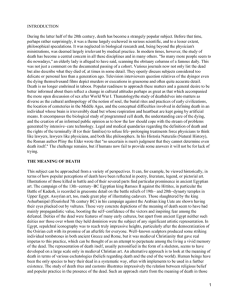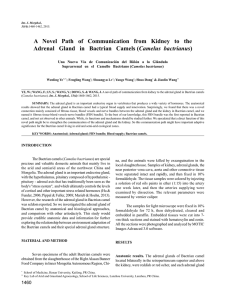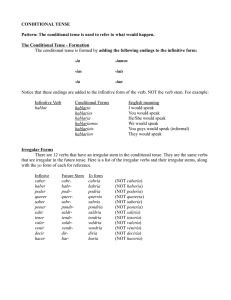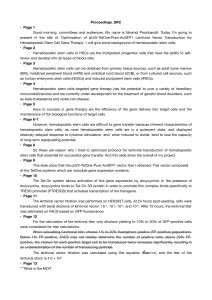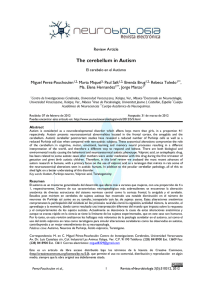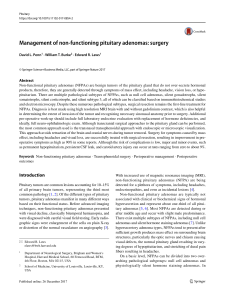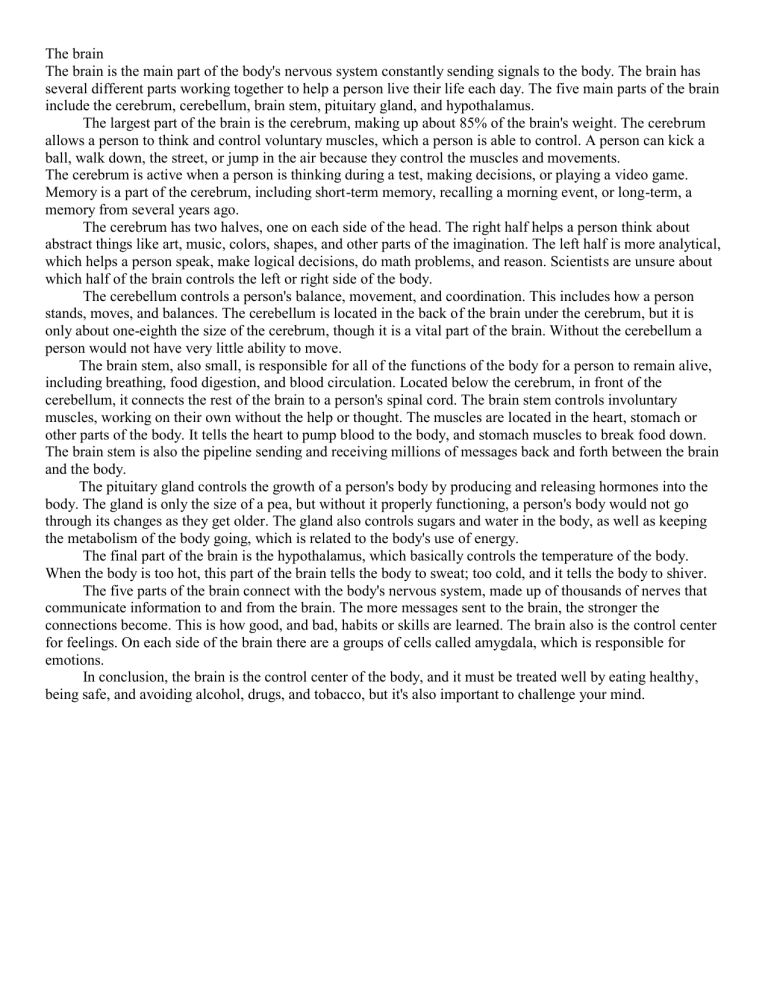
The brain The brain is the main part of the body's nervous system constantly sending signals to the body. The brain has several different parts working together to help a person live their life each day. The five main parts of the brain include the cerebrum, cerebellum, brain stem, pituitary gland, and hypothalamus. The largest part of the brain is the cerebrum, making up about 85% of the brain's weight. The cerebrum allows a person to think and control voluntary muscles, which a person is able to control. A person can kick a ball, walk down, the street, or jump in the air because they control the muscles and movements. The cerebrum is active when a person is thinking during a test, making decisions, or playing a video game. Memory is a part of the cerebrum, including short-term memory, recalling a morning event, or long-term, a memory from several years ago. The cerebrum has two halves, one on each side of the head. The right half helps a person think about abstract things like art, music, colors, shapes, and other parts of the imagination. The left half is more analytical, which helps a person speak, make logical decisions, do math problems, and reason. Scientists are unsure about which half of the brain controls the left or right side of the body. The cerebellum controls a person's balance, movement, and coordination. This includes how a person stands, moves, and balances. The cerebellum is located in the back of the brain under the cerebrum, but it is only about one-eighth the size of the cerebrum, though it is a vital part of the brain. Without the cerebellum a person would not have very little ability to move. The brain stem, also small, is responsible for all of the functions of the body for a person to remain alive, including breathing, food digestion, and blood circulation. Located below the cerebrum, in front of the cerebellum, it connects the rest of the brain to a person's spinal cord. The brain stem controls involuntary muscles, working on their own without the help or thought. The muscles are located in the heart, stomach or other parts of the body. It tells the heart to pump blood to the body, and stomach muscles to break food down. The brain stem is also the pipeline sending and receiving millions of messages back and forth between the brain and the body. The pituitary gland controls the growth of a person's body by producing and releasing hormones into the body. The gland is only the size of a pea, but without it properly functioning, a person's body would not go through its changes as they get older. The gland also controls sugars and water in the body, as well as keeping the metabolism of the body going, which is related to the body's use of energy. The final part of the brain is the hypothalamus, which basically controls the temperature of the body. When the body is too hot, this part of the brain tells the body to sweat; too cold, and it tells the body to shiver. The five parts of the brain connect with the body's nervous system, made up of thousands of nerves that communicate information to and from the brain. The more messages sent to the brain, the stronger the connections become. This is how good, and bad, habits or skills are learned. The brain also is the control center for feelings. On each side of the brain there are a groups of cells called amygdala, which is responsible for emotions. In conclusion, the brain is the control center of the body, and it must be treated well by eating healthy, being safe, and avoiding alcohol, drugs, and tobacco, but it's also important to challenge your mind. 1) Which part of the brain is responsible for short and long-term memory? A: Brain stem B: Cerebrum C: Cerebellum D: Pituitary gland 2) The normally healthy man was having trouble balancing himself as he walked down the street. Which of the following parts of the brain may not have been functioning properly? A: Cerebellum B: Cerebrum C: Hypothalamus D: Amygdala 3) The talented artist became famous not only for her paintings, but also for her poetry. Which part of her brain was most likely functioning very well? A: Left half of the cerebrum B: Left half of the cerebellum C: Right half of the cerebrum D: Right half of the cerebellum 4) Which of the following is an example of an involuntary muscle? A: Arm B: Leg C: Finger D: Heart 5) Which of the following pars of the brain is like a pipeline which sends the messages back and forth between the body and brain? A: Pituitary gland B: Cerebellum C: Amygdala D: Brain stem 6) Which parts of the brain may not have been working properly when the boy in the hospital stopped growing and did not sweat even in hot temperatures? A: Hypothalamus and pituitary gland B: Amygdala and hypothalamus C: Pituitary gland and brain stem D: Cerebellum and pituitary gland


